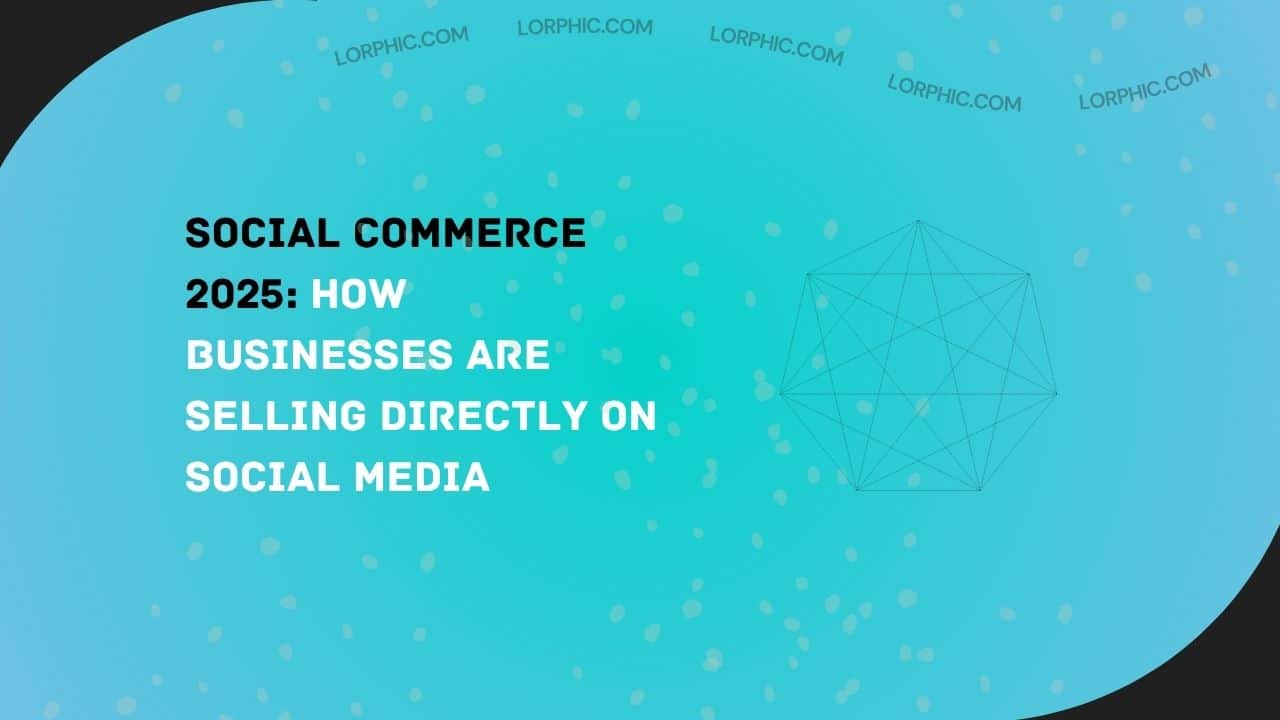Imagine this: a customer is scrolling through their social feed, sees a product video, taps “Buy Now”, and completes a purchase all without ever leaving the app. In just seconds, a brand has converted interest into revenue. Welcome to the era of social commerce.
In 2025, social commerce isn’t just a buzzword it’s rapidly becoming a full-fledged sales channel. For digital marketers and businesses, that means a seismic shift in how we plan strategies, allocate budgets, and drive growth. Let’s unpack where we are, what the numbers say, and how you can capitalize on this trend.

What is social commerce?
At its core, social commerce refers to selling goods and services directly on social media platforms, rather than driving users off to separate e-commerce sites. According to Sprinklr, it “integrates the entire shopping experience from product discovery to purchase and after-sales support within social media environments”.
So instead of seeing a social ad, clicking to a website, adding to cart, then checking out, imagine completing the entire journey inside the social feed with fewer friction points. That’s what social commerce delivers.
For businesses, this means shifting some focus: from solely driving traffic to ecommerce sites, to enabling shoppable experiences inside social apps themselves, making the path to purchase faster and more seamless.
Why social commerce matters in 2025
1. Rapid growth, massive opportunity
The numbers don’t lie. The global social commerce market was estimated at USD 1.16 trillion in 2024 and is expected to reach around USD 1.48 trillion in 2025.
Another projection says that sales through social networks will represent “over 17% of total online sales” by 2025.
In the U.S., social commerce is forecast to hit about USD 114.7 billion by 2025, with a CAGR of ~10.4% from 2025-2030.
2. Changing shopper behaviour
According to data from Hostinger, social commerce penetration is projected to reach ~25% in 2025 meaning one out of four online shoppers might buy via social channels.
And younger demographics are leading the charge: for example, in 2025 Millennials are expected to represent ~33% of global social commerce spending, with Gen Z around 29%.
3. Platforms are built for it
Social platforms like Instagram, TikTok and Facebook are actively enhancing features such as shoppable posts, live-stream checkouts, influencer-driven links, in-app payments and checkout flows. This means the ecosystem is ready for brands to plug-in.
4. Lower friction = higher conversions
Because the transaction happens where the user already is (their social feed), the drop-off between “I like this product” and “I buy this product” is reduced. The result: faster, more impulse-friendly purchasing, often driven by content, community, and immediacy.
Key Trends for social commerce in 2025
A. Live-stream shopping events
Live commerce where a host or influencer shows products in real time, engages with viewers, answers questions, and invites immediate purchases is becoming mainstream. According to DHL’s “2025 Social Commerce Trends” report: 66% of shoppers say they are interested in live-stream shopping events.
B. Influencer & creator commerce
More brands are shifting budget into creators who can showcase products inside social flows, supported by seamless checkout links. With younger shoppers especially trusting creators and peers, this becomes a powerful channel.
C. Mobile-first and in-app checkout
Because most social usage occurs on mobile devices, brands must optimize for small-screen, fast checkout, embedded product links, and minimal redirects. For example, the Hostinger report highlights that many users prefer completing purchases without leaving their social feed.
D. Personalisation, AI & social proof
Personalized recommendations, content based on behavior, user-generated content (UGC) as social proof all are central. Sprinklr reports UGC can increase conversion rates significantly.
E. Regional nuance & mobile-first markets
The Asia‐Pacific region leads: it accounted for ~71.6% of the social commerce market share in 2024. Grand View Research For businesses expanding globally, region-specific strategies (language, payment, culture) matter.
F. Seamless logistics & returns
Buyers expect social commerce to match e-commerce standards: free or easy returns, fast delivery, trust in checkout. According to DHL, 58% of shoppers want free delivery & returns on their social media purchases.
What this means for businesses in the digital marketing space
Here are practical takeaways for your agency (or your clients) to leverage social commerce effectively.
1. Choose platforms strategically
Not all social platforms are equal for commerce. Example stats: In the U.S. in 2025, ~69.4 million people are expected to shop via Facebook, ~47.5 million via Instagram, ~37.8 million via TikTok. sellerscommerce.com
Select platforms based on your target demographic for example, if you’re targeting Gen Z, TikTok and Instagram are critical; for older demographics, Facebook still dominates.
2. Build a shoppable storefront presence
Ensure your brand has a properly configured “shop” or catalogue on the social platform: product tags, shoppable posts, embedded checkout where possible. Social commerce is fundamentally about enabling purchase within the social context rather than just driving traffic out.
3. Create engaging, content-led product experiences
Since social commerce plugs into discovery, not just purchase, use content to inspire:
- Short videos, reels, stories showing products in real life
- Live events with Q&A and call-to-actions
- Influencers or creators demonstrating products
- UGC customers showing how they use the product
4. Optimise checkout experience
The fewer steps between discovery and purchase the better. Look out for:
- One-click or integrated checkout inside social platform
- Mobile-friendly UI
- Trust indicators: reviews, testimonials, social proof
- Easy returns and shipping transparency (important as per DHL data: 58% want free delivery & returns)
5. Tailor measurement & attribution
Because the journey happens inside social platforms, tracking attribution from discovery to purchase may need new tools. Invest in analytics that track: platform-specific conversion, live event outcomes, creator-driven traffic, UGC impact.
6. Consider region, culture and payment flows
If you or your clients are targeting global markets (e.g., Pakistan → U.S. or Europe), consider:
- Local payment solutions and currencies
- Integrations with social commerce features in target markets
- Cultural relevancy of content (e.g., formats, language, norms)
- Shipping, returns and logistic expectations
7. Address trust, brand safety and returns
Brands must ensure: safe checkout, clear invoicing, returns policy. A friction-free post-purchase experience is critical for retention and loyalty within social commerce ecosystems.
Challenges to watch
- Platform dependency: You are subject to the algorithms and rules of social platforms. To reduce risk, maintain diversified channels.
- Attribution complexity: Following buyer journeys inside social platforms can be opaque tracking and measurement may lag.
- Logistics & fulfilment pressure: Social commerce demand may scale fast; brands must ensure supply chain, returns and customer service keep pace.
- Regional regulatory, payment and data privacy issues: As social commerce expands globally, different markets have different laws, payment norms and consumer expectations.
- Content fatigue and authenticity: Consumers are increasingly sceptical of obvious “sales” posts. Social commerce success often leans on authenticity, community, UGC. See the beauty industry example where trust in influencers dropped and peer-content gained.
Future outlook: What to expect beyond 2025
Looking ahead, we can anticipate a few major shifts:
- Augmented Reality (AR) & immersive shopping inside social feeds: Expect more try-on, visualisation and interactive formats to increase conversion.
- More creator-led storefronts: Micro-influencers and community creators will increasingly open mini-shops inside social apps.
- Integration of social commerce with live shopping, games and gamification: Live shopping numbers continue to grow; according to DHL, 66% of shoppers are interested in live-streamed shopping events.
- Stronger analytics and AI-driven personalisation: Platforms will use AI to match products to users in real time inside social feeds.
- Greater international expansion and localization: Growth will continue fastest in mobile-first regions such as Asia-Pacific (which already held ~71.6% share in 2024).
- Integration with metaverse, social VR, and new commerce formats: Some brands are already experimenting with immersive social store experiences.
For your business, staying ahead of these trends ensures you’re not just participating in social commerce, but leading the charge.
Ready to implement? Checklist for digital marketing agencies
- Audit current social-commerce capability: Are your “shop” sections configured on Instagram, Facebook, TikTok?
- Map your target audience to the right platforms: Demographics, region, purchasing behaviour.
- Develop content strategy: Focus on discovery-led, shoppable content, live events, UGC.
- Configure checkout flows and logistics: Partner with fulfilment, shipping, return frameworks aligned with social commerce.
- Set KPIs specific to social commerce: e.g., conversions inside social, average order value from social, live-shopping engagement, creator-ROI.
- Integrate analytics & attribution: track which posts, creators, events are driving purchases.
- Test & iterate: run live-stream events, test influencer collaborations, measure results and refine.
- Scale wisely: as you grow, ensure logistics, customer service, return policies scale too.
Why now is the moment
If you’re hesitating, consider the risk of falling behind. With projections showing social commerce reaching 17% + of online sales by 2025, and major consumer behavior shifts underway, the window to build early advantage is open.
Brands that integrate commerce into social feeds now will be far better positioned than those still relying purely on external e-commerce sites. The friction gap is closing quickly.
Curated by Lorphic
Digital intelligence. Clarity. Truth.




